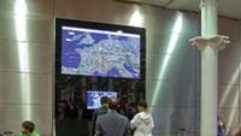
NEC LCD 3210
Oct 1, 2005 12:00 PM,
By Jeff Sauer
Large LCD panel offers good image quality in a variety of professional installation situations.
LCD monitors are now the norm when it comes to new computer desktops, and the economy of scale is affecting larger, installation-oriented panels as well. Whether the application is digital signage, videowalls, or more straightforward conference room installations, LCD panels of 30in. and larger are becoming increasingly affordable. They’re also increasing in quality.
NEC’s LCD 3210 (NEC lists a typical street price of $2,699, but I’ve found them on the Web for less than $2,000) is the smallest of the family of three products that also includes the 40in. LCD 4010 and the 46in. LCD 4610. Together they mark NEC’s latest generation of LCD panels and, in many ways, the overall state of the technology for business and commercial LCD displays. They feature the very common native LCD-panel resolution of 1366×768, a 16:9 aspect ratio, and a professional array of digital and analog connection options.
These options start with a digital-only DVI-D data connector, but also include a standard 15-pin RGB (in and pass-through out) and 5xBNC RGBHV that can be used for component video. There is also a set of 3xBNCs for component and HD video, as well as S-Video in/out and composite (RCA and BNC) in/BNC out.
Other connectivity options include an RS-232 control port; two RCA audio pairs; a stereo mini in; and on-pair audio out, with a 7W stereo audio amplifier. Mountable side speakers are optional.
PROFESSIONAL FEATURES
The LCD 3210-BK I tested was built into the same black bezel and frame as many of NEC’s and NEC/Mitsubishi’s previous LCD panels. It’s appropriately elegant and understated for business and commercial installations in that it has no visible buttons or markings on the front bezel or the top and sides, save the NEC logo and the green power indicator near the IR remote sensor.
All the tactile onscreen menu buttons are tucked up underneath the bottom bezel and are actually closer to the connection ports in the bottom rear. What’s more, even those OSM controls are small and unlabeled to discourage public tampering. They can even be locked out entirely by depressing and holding a combination of buttons. The IR remote has a similar lock feature.
More interestingly for larger installations, a built-in matrix technology makes the LCD 3210 an easy solution for videowalls. NEC’s TileMatrix feature allows you to configure up to a 4×4 array (5×5 on the LCD 4010 and LCD 4610) of panels solely from configuration options in the onscreen menus, without any additional software. You simply need to choose how many vertical and horizontal panels are in the matrix, and assign each panel a number, and the TileMatrix technology divides the source input over the entire videowall. Additionally, TileComp lets you resize the image in each sector to compensate for the width of the bezel and make a more seamless image.
Of course, that involves looping the signal through multiple monitors and, if you have a large matrix of a dozen panels or more, you might run into signal integrity issues that require additional hardware. However, NEC’s configuration options do include a long-cable video EQ function that allows you to optimize the tailing of red, green, and blue. You can also select high (2.2K) or low (75Ω) termination.
Naturally, the LCD 3210 also has the obligatory picture-in-picture function that lets you combine a data source with a video source. Surprisingly, given the maturity of PIP functionality, NEC doesn’t offer extensive PIP control — just a selection of a small, medium, or large inset, and only awkward reposition options for the IR remote.
IMAGE TESTING
In my tests, the LCD 3210 did a very good job of reproducing accurate primary and secondary color. Green and red were almost perfect on the CIE chart, although blue, as is most often the case, was a little inside the CIE triangle. I was even more impressed with the secondary colors — cyan, magenta, and yellow — which are rarely as accurate as they are with the LCD 3210. It shows that NEC has done an excellent job getting the most out of LCD color.
Of course, the true limitation of LCD technology is achieving warm and accurate color in non-saturated colors, such as varying shades of orange, greens, and skin tones. That’s where the subtractive nature of LCD color reproduction has a harder time achieving photo-realistic results and why true colorists and graphic artists frequently still use CRTs. The LCD 3210 does about as well as possible with solid colors, but still suffers from this common LCD shortcoming.
On the test bench, these factors are most visible in grayscale measurements. Using 10 levels of grayscale, the LCD 3210 produces a nice smooth curve as brightness increases from black to white. However, as the number of grayscale samples increases even to 20, and especially with 32 or more, the curve starts to look more like a staircase. And since any shade of gray is already a function of red, green, and blue blended together, shifting toward any color wouldn’t change the number of visible steps from dark to light. That inherently modest color depth, plus a solid but not industry-leading 18ms response, make the LCD 3210 good for motion video, but not in the class of plasma.
I was very pleased with the near 90 percent brightness uniformity NEC has achieved with the LCD 3210, from the center of the screen to the edges. However, NEC’s claim of 500cd/m2 is much like the rest of the industry’s specification reporting — not that realistic. With the panel set up properly against a standard pluge, I measured no more than 242cd/m2. Even by overdriving brightness I measured no higher than 365cd/m2. A contrast ratio of 416:1 comes a little closer to NEC’s 600:1 mark.
Overall, however, the LCD 3210 delivers very good image quality, especially as a digital signage or other information-oriented display. More importantly, it’s designed to easily fit and operate in a variety of professional installation situations thanks to features like TileMatrix and smart industrial design.
PRODUCT SUMMARY
Company: NEC
www.necdisplay.com
Product: LCD 3210
Pros: High-quality images, high brightness uniformity, and accurate color reproduction, especially of secondary colors
Cons: Incomplete, awkward PIP control
Applications: Digital signage, videowalls, and more straightforward conference room installations
SPECIFICATIONS
Viewable image size 31.5in.
Pixel pitch 0.511mm
Native resolution 1366×768
Brightness 500cd/m2 (spec)
242cd/m2 (as tested)
Contrast 600:1 (spec)
416:1 (as tested)
Connections DVI-D, 15-pin, 5xBNC, 3xBNC, S-Video, BNC/RCA composite, 1× 1/8in. audio, 2 RCA audio, serial
Aspect ratio 16:9
Dimensions (H×W×D)
18.9″×31.1″×5.5″
Weight 35.3lbs.
Warranty Three-year standard limited warranty









